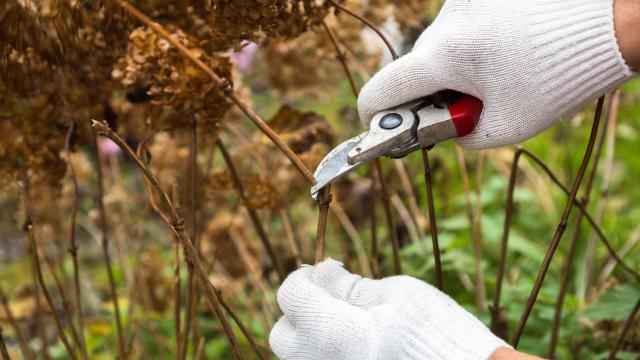As the weather heats up in the back half of summer and you do whatever you can to keep out of the heat, it’s easy to forget some of the essential tasks that will keep your plants plugging away well into autumn. But trimming hedges and perennials, pruning your herb garden, and watering and mulching right now will help those plants produce new blooms and shoots, making for a more colourful and flavorful autumn. Here’s what to do now to get your garden ready.
What you’ll need for mid-summer garden maintenance
Most of you mid- to late summer garden maintenance can be accomplished with trusty garden shears and a good pair of gloves. You might also use larger hedge trimmers for paring back bigger plants. If you plan to change up your watering protocol as the summer heats up, it can be helpful to invest in a new soaker hose or sprinkler.
Don’t skimp on watering
The first thing to think about as your vegetables produce and your flowers begin to die back is watering, and watering some more. Long, hot days can dry out the soil significantly, so making sure that your plants are getting enough water is key. Adding a soaker hose or a drip irrigation system is one way to give your garden enough moisture. Your vegetable plants will produce more, and for longer, given enough water, and your flowers may come out with a surprise second blooming if they’re not dried out. Keeping the roots of your perennials healthy will also allow them to come back stronger next season, so even if you don’t get new buds this year, your water isn’t wasted.
Pruning, deadheading, and cutting back
The next task to tackle is pruning, deadheading, and cutting back perennials. Hedges will thicken and grow more healthy leaves if they’re trimmed periodically. Trimming in mid- to late summer allows plants plenty of time to recover before cold weather hits. Deadheading flowers and trimming back the leaves of perennials can not only help them stay healthy, but it could also lead to a late-season bloom. Trimming and harvesting herbs during the mid to late summer will encourage more shoots to grow, making them more robust. Some herbs like mint and sage may even grow an extra round of flowers.
Capitalise on the weather to tackle weeds
Another great thing about hot, dry weather is that weeds dry out just like other plants. Pulling weeds and cleaning up garden beds littered with dead foliage is one step to keep weeds in check. Pulling weeds before they go to seed will save you many future hours of weeding their progeny next season.
It’s also a good time to go after invasives; when the weather is hot, plants that are cut back aggressively, below the soil line will have a tougher time re-sprouting. This will make you gardening life a lot easier in autumn, particularly if you’re struggling against species like the aggressively invasive himalayan blackberry, which is pervasive in the Pacific Northwest; english ivy, which seems pervasive nearly everywhere it can put down roots; and kudzu, which dominates in the southern U.S. Removing invasives when the weather is hot and inhospitable can help you get rid of them faster.
Add a protective layer of mulch
The hottest part of the summer is a good time to spread mulch, which helps soil hold onto moisture, and keeps plants hydrated. Some gardeners also like to use straw for this purpose, although getting straw that doesn’t come with seeds in tow can be tricky. Adding a protective layer to your garden beds now will also help keep weeds in check, giving you one less thing to worry about later in the season and on into autumn.

Leave a Reply
You must be logged in to post a comment.